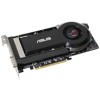- Qualcomm Launches Snapdragon 4 Gen 2 Mobile Platform
- AMD Launches Ryzen PRO 7000 Series Mobile & Desktop Platform
- Intel Launches Sleek Single-Slot Arc Pro A60 Workstation Graphics Card
- NVIDIA Announces Latest Ada Lovelace Additions: GeForce RTX 4060 Ti & RTX 4060
- Maxon Redshift With AMD Radeon GPU Rendering Support Now Available
ASUS GeForce EN9800GT Matrix

Picking out a new graphics card is easier to do now than ever, as there seems to be a model to cover every single price-range, and not just from one single GPU manufacturer, either. Today’s card is one that represents the ~$125 price spot and is designed as a step-up from the 9600 GT, with ASUS applying their usual TLC to help add even more appeal.
Page 6 – Unreal Tournament III
As odd as it may seem, every single game we currently use for our graphic card benchmarking is a sequel or an entry in a series of games, including this one. The original Unreal Tournament launched in late 1999, and since then, it has become a stature with GPU benchmarking. Similar to Call of Duty, the UT series of games is one that manages to deliver spectacular graphics, but doesn’t require a bleeding-edge machine to see them.
UTIII offers a variety of modes and levels, and has some of the most interesting and lush environments ever seen in a video game. If I could choose where I wanted to die, it would most likely be in the Gateway level, which you can see in the screenshot below. This level is one of the most interesting in the game as it’s essentially three levels in one, linked together with portals – and it’s hard to beat the feeling of scoring a portal frag.
The game might be one of the best-looking currently on the PC, but it doesn’t offer robust in-game settings like some others in our suite. Because of this, we are forced to enable anti-aliasing in the control panel of the current graphics card. Both ATI’s and NVIDIA’s drivers allow us to choose 4xAA, so that’s what we stick with throughout all of our testing.



Last our past few tests, this is another game where anti-aliasing will bog down performance tremendously. The game was very playable at 1680×1050, but anything lower would mean certain death constantly.
|
Graphics Card
|
Best Playable
|
Avg. FPS
|
|
Palit HD 4870 X2 2GB
|
2560×1600, Max Detail, 4xAA
|
55.479 FPS
|
|
Palit 9800 GX2 1GB
|
2560×1600, Max Detail, 0xAA
|
78.909 FPS
|
|
XFX GTX 260/216 896MB
|
2560×1600, Max Detail, 0xAA
|
72.954 FPS
|
|
Palit GTX 280 1GB
|
2560×1600, Max Detail, 0xAA
|
72.148 FPS
|
|
Palit HD 4870 512MB
|
2560×1600, Max Detail, 0xAA
|
57.617 FPS
|
|
ASUS 9800 GTX 512MB
|
2560×1600, Max Detail, 0xAA
|
48.874 FPS
|
|
ASUS 9800 GTX+ 512MB
|
2560×1600, Max Detail, 0xAA
|
47.707 FPS
|
|
ASUS HD 4850 512MB
|
2560×1600, Max Detail, 0xAA
|
42.228 FPS
|
|
ASUS 9800 GT 512MB
|
1920×1200, Max Detail, 0xAA
|
57.405 FPS
|
|
Gigabyte 9600 GT 512MB
|
1920×1200, Max Detail, 0xAA
|
43.781 FPS
|
This is one game where 2560×1600 just won’t happen without decreasing the detail levels. Doing that does make a rather noticeable difference, so in this case, we found the best-playable setting to be 1920×1200 with max detail, which gave us a stellar 58 FPS.
Support our efforts! With ad revenue at an all-time low for written websites, we're relying more than ever on reader support to help us continue putting so much effort into this type of content. You can support us by becoming a Patron, or by using our Amazon shopping affiliate links listed through our articles. Thanks for your support!






